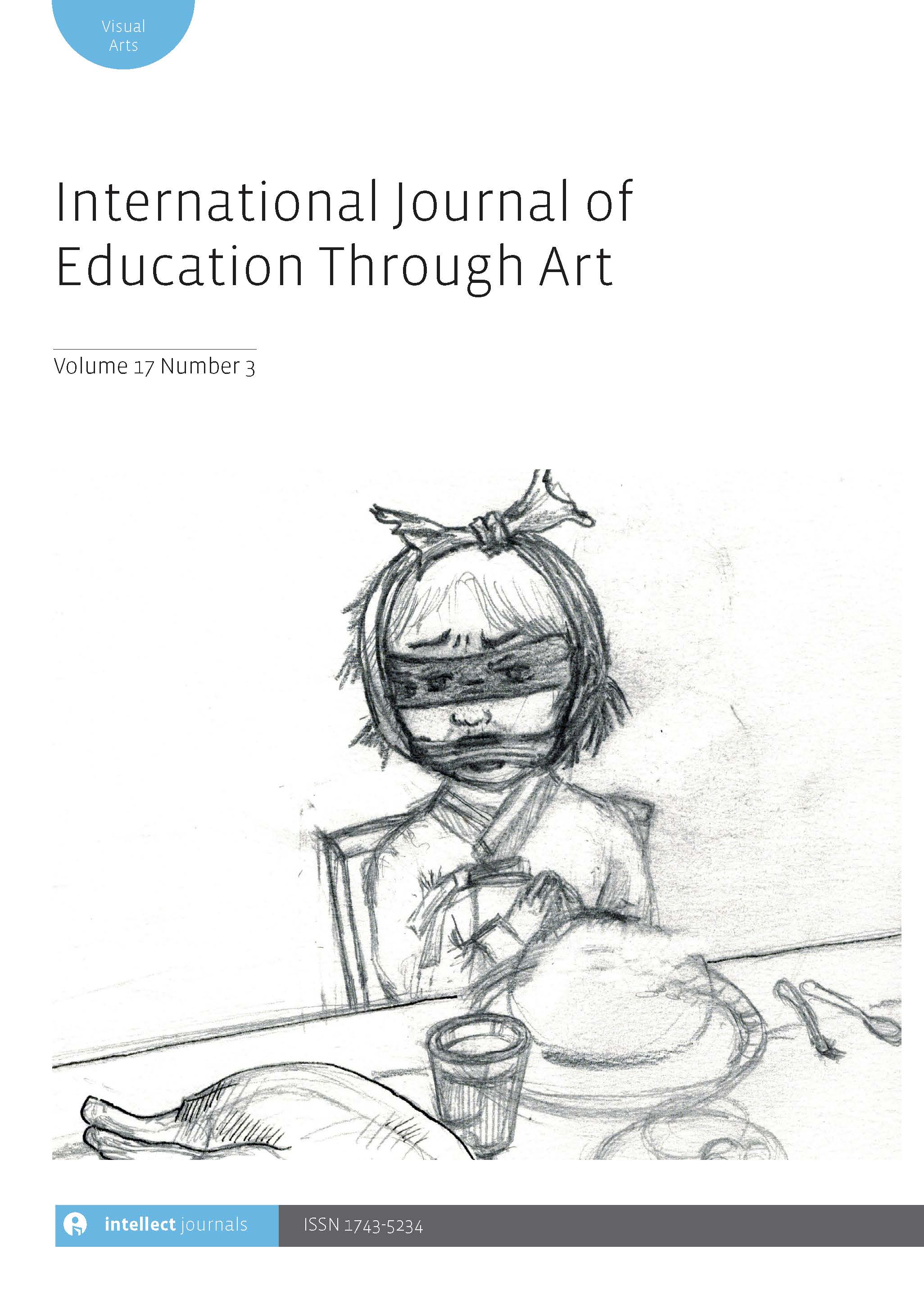Vol. 17 No. 3 (2021): International Journal of Education Through Art

IJETA 17.3 Table of Contents
Editorial
Re-turning education through art
Nadine M. Kalin, Principal Editor, University of North Texas
Mira Kallio-Tavin, Editor, Aalto University
Sheri Klein, Editor, Kent State University
Alexandra Lasczik, Editor, Southern Cross University
Article
Remembering Seonjeong Yi Lebrun: Mourning with narratives of care
Hyunji Kwon, University of South Carolina
It is hard to coherently narrate traumatic memories as they are intensely emotional
and fragmented. I created this narrative inquiry in the hope of enacting care and
performing mourning for the unexpected death of Seonjeong Yi Lebrun (1983–
2017). Seonjeong was a Korean-born art education researcher in Canada whose
work exemplified how artistic approaches to narrative evoke empathy and connectivity.
Her research spanned arts-based self-study to participatory action research
about comfort women (Korean sex slaves for the Imperial Japanese Army during
the Second World War). In performing mourning for Seonjeong through examining
her research, I endeavour to have my research possibly initiate a new form of
arts-based collective care for her, comfort women and those suffering from other
forms of trauma.
Visual Essay
Reconciling with others, within oneself, and the circle(s) of time
Seija Ulkuniemi, University of Lapland
This visual essay depicts my personal experiences with the San peoples of South Africa. Almost twenty years ago, I learned of a personal loss while examining their ancient rock carvings and used the San people’s beliefs about the reconciliation of death and nature to heal. In 2019, I ran a workshop for young Khoe-Sans peoples, offering them a chance to connect and find harmony within themselves. They shared their personal stories and visual creations with each other, reviving the disappearing storytelling tradition. As Indigenous peoples have often been treated as objects without respect, following the ethical rules of research was part of reconciliation. My approach throughout the workshop was to embody connectedness and care; according to the feedback, our interaction succeeded despite our cultural differences.
Articles
Bridging art viewing and making: Constructivist museum tour and workshop
programmes
Juyoung Yoo, Chung-Ang University
The purpose of this study is to investigate how constructivist approaches are conceptualized and implemented in ‘gallery tour and studio workshop’ educational programmes at art museums, and the relationship that exists between the gallery and studio learning for children. A qualitative multi-case study was employed, and three art museums were involved. Data collection methods included programme observations, participant interviews, photos and museum documents. The findings
of the study offer examples of educators’ teaching approaches, which reflect constructivist tenets, as well as factors that might strengthen the connection across gallery and studio learning. An inviting learning environment, consideration of students’ prior knowledge and experience, use of themes and motivating questions and facilitation of reflections, as well as educators’ collaboration all promoted well-connected tour and workshop programmes. This study offers insights and strategies to interested museum professionals and educators who aim to provide children with meaningful and well-connected art-viewing and art-making programmes.
The perception of students’ pre-sketching by architecture educators
Leyla Alipour, University of Tehran
Different individuals have different perception of artworks. This study aims to find the differences between architecture educators and other interpreters in perceiving architecture students’ pre-sketching. For this purpose, the images of architecture students’ pre-sketches were interpreted by three groups. The information perceived from the students’ pre-sketching was coded and categorized as description, analysis, cognition, emotion, artist and evaluation. The results indicate that the focus of architecture educators was on formal aspects, architects tended to notice students’ architectural abilities while interpretations of educators from other disciplines emphasized the perception of meaning and emotion. The results also show the special role of educators’ perception in education through art.
Visual Essay
Working manifesto/a for rovers
Jodi A. Patterson, Eastern Washington University
This arts-based exploration offers potentiality and theory to the wider arts-based research field by expanding and naming embodied experience as it relates to mechanical means of transport. The author dubs such a practice of physically moving the body between vast and varied spaces to be a roving art practice. She offers modes of potential, a preliminary list of protocols to contextualize a rover’s manifesto/a and ways to use roving as an educational tool applicable to the field of art education.
Article
Remixing real and imaginary in art education with fully immersive virtual reality
Martina Paatela-Nieminen, University of Helsinki
This article explores digital material/ism by examining student teachers’ experiences, processes and products with fully immersive virtual reality (VR) as part of visual art education. The students created and painted a virtual world, given the name Gretan puutarha (‘Greta’s Garden’), using the Google application Tilt Brush. They also applied photogrammetry techniques to scan 3D objects from the
real world in order to create 3D models for their VR world. Additionally, they imported 2D photographs and drawings along with applied animated effects to construct their VR world digitally, thereby remixing elements from real life and fantasy. The students were asked open-ended questions to find out how they created art virtually and the results were analysed using Burdea’s VR concepts of immersion, interaction and imagination. Digital material was created intersubjectively and intermedially while it was also remixed with real and imaginary. Various webs of meanings were created, both intertextual and rhizomatic in nature.
Book Review
Education, Arts and Sustainability: Emerging Practice for a Changing World,
Mary Ann Hunter, Arnold Aprill, Allen Hill and Sherridan Emery (eds) (2018) Reviewed by Kudrat-E-Khuda Babu, Daffodil International University, Bangladesh
Video Review
‘The cultural underpinnings of creativity’, Natascha Radclyffe-Thomas (2018) Reviewed by Nicholas Houghton, University for the Creative Arts, UK
